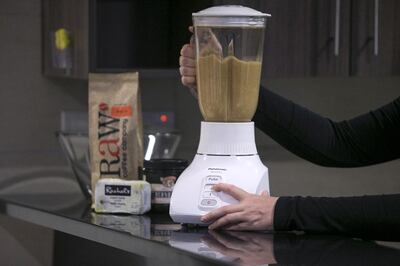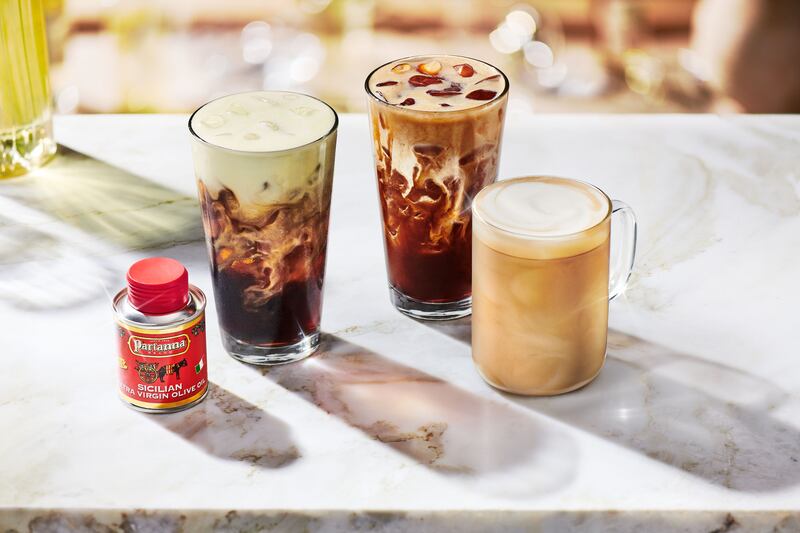Just when you thought you had coffee all figured out, a new drink comes along to rewrite the rulebook. This time it’s Starbucks shaking things up by launching a range of drinks infused with extra virgin olive oil.
The idea for the line, known as Oleato, which made its debut in Milan in February and will launch in the Middle East, the US, the UK and Japan later this year, came to Starbucks’ chief executive Howard Schulz while travelling in Sicily. Having embraced the Mediterranean ritual of drinking a spoonful of extra virgin olive oil with his morning coffee, Shultz reportedly decided to sample the two together, resulting in what he described as “an unexpected velvety, buttery flavour that enhanced the coffee and lingers beautifully on the palate”.
While contemplating whether a coffee finished with a dressing of grassy, golden olive oil might (or not) be your cup of joe, it seems fitting to consider what else should we be adding to our coffee, and why?
Spice up your cup
This is a simple enough way to ramp up the taste of coffee. Adding complementary spices — think cardamom, cinnamon, allspice, ginger, nutmeg or star anise (either on their own or as a custom blend) — imbues coffee with extra flavour and an appealing fragrant aroma. It’s entirely up to you whether you fold powdered spices through pre-ground beans, or make that extra bit of effort and grind both beans and spices from scratch. Either way, once beans and spices are combined, your next step should be to add a small pinch of salt to really round out the flavours (more on this below).
Butter in coffee

What do you get if you blend butter into your brew? Bulletproof coffee, which attracted controversy and converts in droves in 2018. This is the high-calorie, high-fat drink purported to boost energy and focus levels while also suppressing appetites. If that appeals, a few caveats to be aware of: the butter must be grass-fed, the oil should be the MCT (medium-chain triglyceride) variety and the coffee beans high-quality. Taste-wise, expect a drink with creamy, frothy, latte-style vibes.
Salty stirs
As keen cooks will attest, salt amplifies the flavour of most other ingredients, reducing bitterness while simultaneously enhancing sweet, sour and umami tastes. The principle applies to coffee, too; salt can be used to balance the acidity of the beans, drawing out the sweeter, more aromatic flavours.
While adding salt to coffee might sound unconventional, the practice is a long-established one. During the Second World War, sailors are said to have used table salt to make poor-quality coffee more palatable, while Turkish pre-wedding tradition sees the bride-to-be liberally sousing her future husband’s coffee with salt. If the groom consumes the drink without visible complaint, it’s seen as a sign of his good temperament (and a nod to the fact that marriage isn’t always sweet). In Taiwan, meanwhile, Sea Salt Coffee — lightly sweetened iced coffee finished with a layer of sea salt cream — is something of a viral drink made famous by the international bakery and cafe 85C.
Coffees and cream
Adding a splash of half-and-half (half whole milk, half cream) to coffee is common practice in the US and for good reason — it gives the drink a thicker, more luscious texture than milk alone, while not being quite as indulgent as swirling in pure cream.
If you fancy giving it a try, look for dairy products with between 18 per cent and 30 per cent milk fat (often labelled light cream), steering clear of fat-free versions sweetened with corn -syrup. Alternatively, make your own by mixing milk and cream and shaking the two together until well combined.
Taking the idea of adding cream to your coffee (or rather coffee to your cream), in a more decadent but delicious direction, is affogato. Meaning “drowned” in Italian, the classic, single-serve dessert takes minutes to prepare and only calls for two ingredients: freshly brewed espresso and gelato.
Nitrogen cup of joes
Coffee lovers will likely already know about this one. Charging cold brew coffee with nitrogen is said to enhance both the flavour and texture of the drink, with the tiny bubbles creating a smooth, velvety texture likened to that of nitro draft hops. The gas also gifts the coffee a creamy, slightly sweetened taste that many say negates the need for milk or sugar.
Keen for a taste of the velvety action? You’ll find nitrogen cold brew tap systems in place at a number of coffee shops and cafes across the Emirates, plus cans of ready-to-drink nitro brews in supermarkets.
Recreating the experience at home is a little more complicated than the other options on this list, but is possible with the right bits of kit. That means either purchasing a specially designed (and quite pricey) Nitro Cold Brew Coffee Maker or going the DIY route and using a small, whipped cream dispenser charged with nitrogen gas cartridges.
A real lemon
While serious coffee enthusiasts and expert baristas might take umbrage to requests for flavoured syrups, it's probably one to put down to a matter of taste. Less palatable has to be the TikTok trend for drinking instant coffee with a squeeze of lemon juice first thing in the morning. Billed as a weightless hack (without the medical evidence to back it up), the #LemonandCoffee challenge might be racking up plenty of views, but that still doesn’t mean it will taste good. Sip at your own risk.






